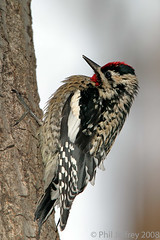
In the late half of this winter we've seen two noteworthy NYC vagrants - the Union Square Scott's Oriole and the Central Park Western Tanager - help their survival prospects by taking advantage of a less conventional food source of plant sap. Both the Oriole and Tanager have been seen drinking from sapsucker holes. Both of these sites happened to be on Viburnam bushes - an exotic hardy evergreen shrub that is present on both of these city parks. Later in the winter the Scott's Oriole was re-found in Thompkins Square Park doing exactly the same thing - drinking sap from Sapsucker holes in Viburnam.
Last winter an almost-overwintering Cape May Warbler in Riverside Park in Manhattan was seen drinking sap from Sapsucker holes, although these were probably from more native trees than Viburnam shrubs. Exploitation of sapsucker holes by Cape Mays is not an uncommon thing to observe in the Pinetum region of Central Park in late fall or early winter.
Shai Mitra, via the NYSBirds-L list made the observation that the numbers of overwintering Yellow-bellied Sapsuckers have been greater in recent years. Unfortunately I can't locate a reference for that observation. The BNA account for this species illustrates that it has a wide wintering range, with NYC being at the extreme north-eastern edge of it. It remains to be seen what influence non-native plants have on this range, because the Sapsucker doesn't appear to be all that picky over which plant to use. So a lot of unanswered questions. Certainly vagrants aren't obliged to exploit Sapsuckers - the 2006/7 Western Tanager in NJ was eating Juniper berries - but perhaps it indicates that the vagrants or out-of-seasonal rarities that we observe are the ones that are most resourceful in exploiting local food sources. Memorably the Scott's Oriole may have chosen to hang around the small corner of Union Square Park because the fruit offerings at the Ghandi statue offered it a supply of palatable food - it's a nectar drinker during the summer but eats fruit on the wintering grounds in Mexico.

No comments:
Post a Comment